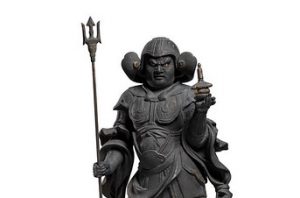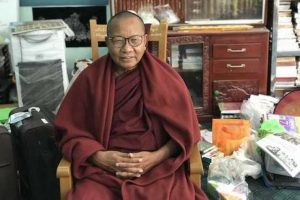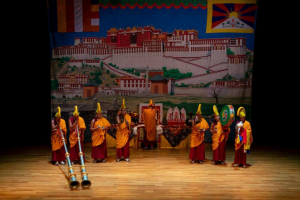The Indian subcontinent, including present-day Bangladesh, has witnessed the flourishing of Buddhism for 2,600 years. Thousands of Buddhist monasteries and monuments were established throughout this region. After wars and invasions in the 11th century, Buddhism massively declined across the subcontinent, with many ancient monasteries and monuments destroyed or abandoned. Archaeologists began unearthing Buddhist sites in the mid-19th century. Śrīmat Jagat Chandra Mahāsthabir (1850–1948) was one of those Buddhist scholars and archeologists who helped to discover eminent Buddhist sites in Bangladesh.
Śrīmat Jagat Chandra Mahāsthabir was born in 1850 in a prominent Buddhist village named Unainpūra, in the sub-district of Patiya and district of Chattogram, also known as Chittagong, in Bangladesh. As a boy, he received a Buddhist education and studied Burmese manuscripts, becoming a monk. Jagat Chandra was a disciple of the legendary Theravāda monk Ācāriya Pūrṇāchār Chandramohan Mahāsthabir (1834–1907). Ācāriya Pūrṇāchār Chandramohan Mahāsthabir was also the second supreme patriarch of Bangladesh. Inspired by his teacher, Jagat Chandra explored a variety of potential locations for Buddhist archeological sites, several of which were successful.

One of Jagat Chandra Mahāsthabir’s most important discoveries was uncovered in Rangkut Banasram Bihar, in the Ramu sub-district of Cox’s Bazar. Accompanied by his master, Jagat Chandra traveled to Arakan State, now Rakhine State in Myanmar. During their trip, they visited various Buddhist monasteries and libraries to find information on hidden archeological sites and manuscripts in the Bangladesh region.
While exploring ancient Buddhist scriptures, they found the Dhaiya Wadi Bajhoyaing. In this book, Pūrṇāchār Chandramohan and Jagat Chandra found information about an ancient Buddhist monastery, Rangkut Banasram Bihar, located in southern Bangladesh. The book also mentioned that Emperor Ashoka (c. 269–232 BCE) constructed Rangkut Banasram Bihar in 268 BCE, and that this vital monastery preserved the Buddha’s holy bone relics.
Pūrṇāchār Chandramohan and Jagat Chandra were naturally excited to find out more, and returned to Chattogram and began planning how to discover Rangkut Banasram Bihar. Despite Ācāriya Pūrṇāchār Chandramohan Mahāsthabir passing away in 1907, Jagat Chandra did not lose courage. The disciple continued his search for the exact location of the site. With the support of local Buddhists in Ramu’s subdistricts, Jagat Chandra identified the location of Rangkut Banasram Bihar in 1929.
It was evening time in the deep jungle. Jagat Chandra was searching for the location when he and his team noticed a high mound covered by the branches of a banyan tree. There was a brick-built structure inside the tree. Jagat Chandra asked one of his team members to uncover the structure. It was a magical moment when Jagat Chandra and his excavation team discovered a space that appeared to be the monastery’s entrance gate. The excavation team stopped work for that day, and in the morning continued their work with newfound enthusiasm.
As they searched the area, they found a broken Buddha statue and a stone, on which information about Rangkut Banasram Bihar was written in Burmese. Although Jagat Chandra was an expert in Buddhist manuscripts and Burmese liturgical language, it took him some time to read all the writing on the stone. After verifying the epigraphic evidence, Jagat Chandra expressed profound joy and declared that he and his team had made a historical discovery. They had finally unearthed Rangkut Banasram Bihar of Ramu.
The Burmese stone-carved writings were a fascinating discovery that gave weight to Jagat Chandra’s mission and hypothesis, along with revealing the record of the historical Buddha’s trip to the region of Bangladesh and Arakan State in present-day Myanmar. The stone contained the following information:
When King Maha Chanda Suriya, the ruler of the kingdom of Dhanyavati, invited the Buddha and his disciples to stay a night at Rangkut Banasram Bihar in Ramu. At that time, the Buddha mentioned that there would be a future king named Ashoka who would replace [the Buddha’s] bone relics at this place, named Ramu Rangkut Chetiya. The Buddha further stated that King Chedi, the successor to King Maha Chanda Suriya, would build a Buddha statue on a green stone. The statue’s head would store the Buddha’s bone relics. At that time, the place would be renowned as Ramu Rangkut Maha Chadi.

After reading the meaning of the epigraphy, Jagat Chandra and his team were celebrated for discovering the historical location that held the imprints and legacy of the Buddha. Jagat Chandra then instructed his team to search for the Buddha statue. In the meantime, they found some broken fragments that seemed to be part of a Buddha image. Jagat Chandra mentioned to his team that if they did not find at least the head of the statue, the mission would not be successful.
As the team removed the branches of a banyan tree from the high mound, Jagat Chandra saw a chaitya that looked like an umbrella. He also saw some ruins of a pillar of Ashoka, which confirmed that this was the exact place of Ramu Rangkut Maha Chadi that they had been seeking for years. Afterward, they found more broken parts of the Buddha statue, which, when reunited with the other fragments, looked like a 2.4-meter statue without head and hands. This incomplete statue assured them that it was the image where the Buddha’s bone relics were stored. The next day, Jagat Chandra and his team discovered the head of the statue. It was a phenomenal moment when they found the Buddha’s bone relics within. Jagat Chandra instructed his team to reunite all parts of the statue and invited the local Buddhists to pray before the historical Buddha relics.

Jagat Chandra’s discovery of Rangkut Banasram Bihar in 1929 made the site famous throughout Bangladesh. Devotees rebuilt the area and restored the historical statue. Jagat Chandra’s monumental discovery is commemorated by local Buddhists with a gathering during the Bengali New Year, when they take the opportunity to offer respects before the restored Buddha image.
Jagat Chandra also worked tirelessly to relocate two important historical Buddhist pilgrimage sites: Tegarpuni of Buṛā Gosai and Pharātarā Caitya of Chakrashila. Both places represent the glorious past of Buddhist transmission in ancient Bengal. After confirming the locations through his research, Jagat Chandra told devotees and seekers to reconstruct and preserve them. He stayed at Ukhiya Parabari Ananda Bihar, in Cox’s Bazar, from 1926–37, then stayed at his beloved Rangkut Banasram Bihar, before passing away in 1948.

Jagat Chandra’s will was that his body be returned to his birthplace, Unainpūra, with his ashes laid beside his mentor, Ācāriya Pūrṇāchār Chandramohan Mahāsthabir. Therefore, years later, Dr. Dharmasen Mahāsthabir (1928–2020), the 12th supreme patriarch, brought Jagat Chandra’s ashes to Unainpūra. Suman Kanti Barua, a social worker and businessman from Unainpūra, constructed a memorial chaitya for in 2015, where Jagat Chandra’s ashes are respectfully preserved.
Jagat Chandra Mahāsthabir’s legacy of discovery and restoration is significant. His passion and love for discovery remains in the hearts of Bengali-speaking monks, devotees, and the Buddhist community across South Asia and beyond.
References
Barua, Shimul. 2012. Bānlāra Baud’dha: Itihāsa-Aitihya O Sanskr̥ti. Chattogram: Anōmā Sanskr̥ti Gōsṭī.
Barua, Dr. Pravat Chandra. “Ramu’r Rangkut Bihar’er Abiskarak Śrīmat Jagat Chandra Mahāsthabir.”
Mahastabir, Praggajyoti and Prajna Bangsha Mahastabir (edited). Itihash O Oitijjhe’r Sondhane Bangladesher Prachintama Bouddho Thirtha Rang-U-Rangkut.
Mahathero, Prajna Bongsha. “A Brief History of Raungkut (Ramcot) Stupa of 3rd Century B.C.” Ahmed Din Rumi.”O’itihasik Ramu Rangkut Boudho Bihar’er Itikotha: Bhadanto Jagat Chandra O Rangkut Pracinota Path.”
Related features from BDG
Unainpūrā Sukhlāl Subedār Maṭha: A Forgotten Historical Buddhist Site in Bangladesh
The Bengali Buddhist Renaissance in the Pālā Dynasty
Ācāriya Pūrṇāchār Chandramōhan Mahāsthabira (1834–1907): The Life and Work of the 2nd Saṅgharāj of Bangladesh
Āryaśrābaka Gyaniswer Mahāsthabir (1887–1974): The Life and Legacy of a Seminal Bangladeshi Theravada Master











